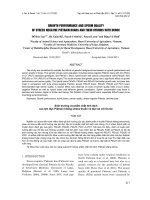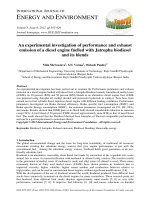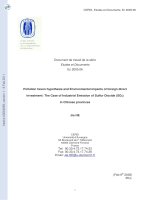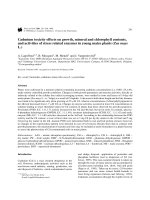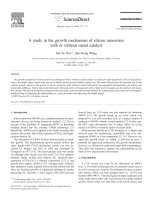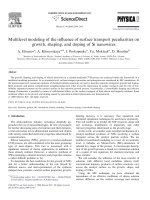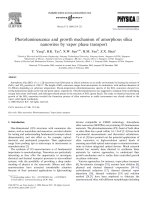- Trang chủ >>
- Khoa Học Tự Nhiên >>
- Vật lý
synthesis, growth mechanism and room-temperature blue luminescence emission of uniform wo3 nanosheets with w as starting material
Bạn đang xem bản rút gọn của tài liệu. Xem và tải ngay bản đầy đủ của tài liệu tại đây (313.6 KB, 4 trang )
Synthesis, growth mechanism and room-temperature blue luminescence
emission of uniform WO
3
nanosheets with W as starting material
Jinmin Wang, Pooi See Lee
Ã
, Jan Ma
School of Materials Science and Engineering, Nanyang Technological University, Nanyang Avenue, Singapore 639798, Singapore
article info
Article history:
Received 21 July 2008
Received in revised form
24 October 2008
Accepted 5 November 2008
Communicated by K. Nakajima
Available online 13 November 2008
PACS:
68.70.+w
81.05.Dz
81.10.Dn
81.20.Ka
Keywords:
A1. Crystal morphology
A2. Growth from solutions
B1. Nanomaterials
B1. Oxides
abstract
Uniform single-crystalline tungsten oxide (WO
3
) nanosheets have been synthesized in a large-scale
with W powders as starting material. The results from the thermal stability meas urements show that
the as-synthesized WO
3
nanosheets are anhydrous. Their thickness and length are $80 and $500 nm,
respectively. They exhibit blue luminescence emissions at $431, 486 and 497 nm, UV emissions at $362
and 398 nm. The blue emissions are resulted from the band–band indirect transition and the UV
emissions should be attributed to the defect states of WO
3
. The growth mechanism of the two-
dimensional WO
3
nanosheets is discussed.
& 2008 Elsevier Ltd All rights reserved.
1. Introduction
Blue luminescence emission has attracted much attention due
to the applications in short-wavelength laser [1], light-emitting
diode (LED) [2] and white light source [3]. A number of blue-
emission semiconductor materials have been studied, such as
GaAs, GaN, ZnSe [4–7]. These materials are direct band-gap
semiconductors which readily emit luminescence. On the other
hand, tungsten oxide (WO
3
) is an indirect band-gap semiconduc-
tor [8], which has been extensively studied due to their
applications in electrochromic [9], photocatalytic [10] and gas
sensing materials [11]. Less attention has been paid to the
luminescence properties of WO
3
because of the low emission
efficiency in conventional indirect band-gap semiconductors.
However, recently, much progress has been realized for the
luminescence of WO
3
. Manfredi et al. [12] reported the light
emission in WO
3
thin films, at which the excitation temperature is
at liquid nitrogen temperature. Niederberger et al. [13–15]
realized the room-temperature blue emission of WO
3
nanoparti-
cles in ethanol solution. Feng et al. [8] also reported the room-
temperature strong photoluminescence (PL) of WO
3
nanoparticles
and W
18
O
49
nanowires. It is believed that the particle size,
morphology and quantum-confinement effect played an impor-
tant role for the room-temperature luminescence emission [16].
Recently, a great deal of efforts has been focused on the
morphology control of all kinds of nanostructures due to their
morphology dependent properties [17–23]. Nanosheets, one of
two-dimensional (2D) nanostructures with one distinct thin
thickness, have many special potential applications in electrical,
optical, photochemistry, sensors and ion-exchange properties
[24]. Relative to the comprehensive investigations in zero- and
one-dimensional (1D) nanostructures, 2D nanostructures are
almost neglected for the last decade. One important reason is
the synthesis of single-crystalline 2D nanostructures is more
difficult to control. However, much progress has been achieved
recently for the synthesis of ZnO, TiO
2
,Fe
3
O
4
,Mn
3
O
4
, CoO, Ga
2
O
3
and complex hydroxide nanosheets [24–31]. It is well known that
tungsten oxides contain many non-stoichiometric sub-oxides
(WO
3Àx
). Moreover, some hydrates often exist in the products
from a wet chemical route for the synthesis of WO
3
, making it
difficult to synthesize stoichiometric WO
3
nanosheets. Only a few
research groups reported the synthesis of WO
3
and tungsten oxide
hydrates (WO
3
Á xH
2
O) nanosheets. Polleux et al. [32] successfully
synthesized tungsten oxide hydrate (WO
3
Á H
2
O) nanoplatelets by
ARTICLE IN PRESS
Contents lists available at ScienceDirect
journal homepage: www.elsevi er.com/locate/jcrysgro
Journal of Crystal Growth
0022-0248/$ - see front matter & 2008 Elsevier Ltd All rights reserved.
doi:10.1016/j.jcrysgro.2008.11.016
Ã
Corresponding author. Tel.: +65 67906661; fax: +65 67909081.
E-mail address: (P.S. Lee).
Journal of Crystal Growth 311 (2009) 316–319
heating the system of tungsten chloride (WCl
6
)-benzyl alcohol.
Considering the poor thermal stability of WO
3
Á H
2
O as it can
decompose and release water molecules at higher temperatures,
anhydrous WO
3
will be more stable for practical applications. Kim
et al. [33] reported a similar system of WCl
6
in ethanol to
synthesize WO
3
nanosheets. Recently, Zhang et al. [34] synthe-
sized ultrathin WO
3
nanodisks using poly(ethylene glycol) (PEG)
as a surface modulator. However, the luminescence properties of
WO
3
nanosheets were not studied and only the last paper
proposed a possible growth mechanism for the WO
3
nanodisks.
Moreover, when WCl
6
was used as the starting material, the
reaction medium must be organic solvent because WCl
6
will quite
strongly hydrolyze to release hydrogen chloride in aqueous
solution. Besides, it is expensive to use WCl
6
as the starting
material. So an aqueous approach using common tungsten source
must be developed for the large-scale synthesis of WO
3
nanosheets. Obviously, metal tungsten (W) is the ideal tungsten
source for the preparation of WO
3
. However, up to now, no one
has reported the synthesis of WO
3
nanosheets using W as the
starting material.
Herein, we report a much more economical approach to the
large-scale synthesis of uniform stoichiometric and anhydrous
WO
3
nanosheets from W powder and a successful demonstration
for the room-temperature blue emissions from the resultant WO
3
nanosheets. The blue emissions were attributed to arise from the
band–band indirect transition of WO
3
. And a new growth
mechanism for the as-synthesized WO
3
nanosheets was proposed.
2. Experimental procedure
The precursor was prepared by oxidation of W using hydrogen
peroxide (H
2
O
2
) [35,36]. In a typical synthesis, 6.5 g of W powder
was dissolved into a mixed solution of 40.0 mL of H
2
O
2
and 4.0 mL
of H
2
O with an ice-water bath and stirring. After filtration, a light
yellow solution was obtained. The solution was refluxed at 55 1C
for 6 h, then yellow concentrated sol was formed. After aging at
room temperature, yellow precipitate was separated out and used
as the precursor. A total of 0.4 g of precursor was added into
19.0 mL of de-ionized water to form a suspension and 3 M HCl was
dropped into the suspension until its pH value is up to 1.7. Then,
the suspension was transferred into a Teflon-lined autoclave with
a capacity of 45 mL. The autoclave was placed into an oven and
heated at 180 1C for 24h. After cooling down to room temperature,
yellow product was obtained.
The phase of the product was identified by X-ray powder
diffraction (XRD), using Cu K
a
(
l
=0.15406 nm) radiation in a 2
y
range from 101 to 801 at room temperature. The morphologies of
the as-synthesized WO
3
nanosheets were characterized by field-
emission scanning electron microscopy (FESEM). The FESEM
sample was prepared by coating Pt using a sputtering machine
at a beam current of 20 mA for 45 s. Transmission electron
microscopy (TEM) and high-resolution TEM (HRTEM) images,
selected area electron diffraction (SAED) pattern of the WO
3
nanosheets were obtained using an accelerating voltage of 200 kV.
The thermal stabilities of the precursor and the product are
examined by thermal gravimetric analysis (TGA) in air. The PL
properties of the as-synthesized WO
3
nanosheets were measured
on a fluorescence spectrophotometer with a Xe lamp as the
excitation source at room temperature.
3. Results and discussion
The XRD patterns of the precursor and the product are shown
in Fig. 1a. All the XRD peaks of the precursor can be identified as
tungsten oxide hydrate (WO
3
Á H
2
O) (JCPDS 18-1419). Compared to
the XRD pattern of the precursor, significant differences can be
found from the XRD pattern of the product, showing a chemical
reaction has occurred in the process of hydrothermal treatment.
All of the XRD peaks of the product can be indexed to the
orthorhombic structure of WO
3
(JCPDS 71-0131). No non-
stoichiometric tungsten oxides (WO
3Àx
) and tungsten oxide
hydrates (WO
3
Á xH
2
O) were detected, indicating pure orthor-
hombic WO
3
has been obtained. Strong and sharp diffraction
peaks also indicate good crystallinity of the hydrothermal
product. Fig. 1b shows TGA curves of the precursor and the
product. It can be seen that the precursor has an obvious weight
loss within 150–200 1C, corresponding to the decomposition of
WO
3
Á H
2
O and formation of WO
3
. In contrary, the TGA curve of the
product is almost a straight line, which implies the product do not
contain any hydrate. This result from thermal analysis is well
consistent with the XRD result.
Fig. 2a and b shows the FESEM image and TEM image of the
as-synthesized WO
3
nanosheets. Uniform WO
3
nanosheets with a
thickness of $80 nm and length of $500 nm can be observed.
Further structural characterizations were carried out by HRTEM.
The clear crystal lattices show that the as-synthesized WO
3
nanosheets are single crystals. The calculated lattice spaces are
0.385 and 0.376nm in the 2D plane of a single nanosheet, which
correspond to the plane distances of (0 0 2) and (0 2 0) planes,
respectively. And the angle between the (0 0 2) and (0 2 0) plane is
901. These crystal parameters are well consistent with that from
standard XRD data. It can be regarded that the WO
3
crystals grew
ARTICLE IN PRESS
(001)
(020)
(200)
(220)
(021)
(111)
10
100
98
96
product
precursor
94
92
Weight loss (%) Intensity/(a.u.)
20 30
2 /(°
°
)
Temperature (
°
C)
40 50 60 70 80
50 100 150 200 250 300 350 400
(121)
(221)
(002)
(400)
WO
3
WO
3
. H
2
O
Fig. 1. (a) XRD patterns and (b) TGA curves of the precursor and the product
(showing no weight loss is detected in the product).
J. Wang et al. / Journal of Crystal Growth 311 (2009) 316–319 31 7
along two perpendicular directions, [0 0 2] and [0 2 0] to form 2D
nanosheets.
The formation process of WO
3
nanosheets from W can be
divided into three parts: the formation of precursor, the formation
of WO
3
by decomposition of WO
3
Á H
2
O and growth of WO
3
crystal
nucleus. Peroxy-tungstates were formed by the action of H
2
O
2
on
W [35,36]. After ageing, the precursor WO
3
Á H
2
O precipitated
from the solution, which has been proved by XRD data (Fig. 1a).
The results from thermal analysis show the precursor WO
3
Á H
2
O
can decompose into anhydrous WO
3
at lower temperature than
the applied hydrothermal temperature. So WO
3
can be easily
formed in our experimental conditions. However, the subsequent
crystal growth is dominant for the formation of WO
3
nanosheets.
According to the existing steps of the WO
3
nanosheets (Fig. 2a, b
and d), it is believed that the obtained WO
3
nanosheets grow by
step-growth mechanism which resulted from the periodic bond
chain (PBC) theory developed by Kossel, Stranki and Volmer [37].
According to the step-growth theory [37], an atom adsorbed onto
a facet will diffuse randomly on the surface until it reaches an
energetically favorable site and will subsequently be incorporated
into the crystal structure by generating chemical bonds. This
growth process will reduce the total energy of the atom and the
crystal. If more chemical bonds can be generated at some site, that
site will be the preferred growth site. Compared with a terrace
(smooth surface), a corner of a given crystal can provide more
unsatisfied bonds to generate new chemical bonds with an
incorporated atom. Thus, the crystal will be in a thermodynami-
cally stable state. Why did the WO
3
crystal nucleus grow into 2D
nanosheets instead of 3D crystals? This is due to the distinct
growth rate of different crystal facets with different surface
energy. It is well known that the facets have different atomic
densities and unsatisfied bonds, resulting in variations of surface
energy. The facet with a larger surface area has a smaller surface
atom density, which results in a lower surface energy. For
orthorhombic WO
3
with a=7.341, b=7.570 and c=7.754, the (2 0 0)
facet has the largest surface area and lower surface energy,
resulting in a lowest growth rate in the [2 0 0] direction. In
contrary, the other directions of [0 0 2] and [0 2 0] have higher
growth rate, resulting in the preferred growth along [0 02] and
[0 2 0] directions. Hence the resultant shape of the crystals is a 2D
nanosheet. This mechanism differs from WO
3
nanorods or
nanodisks growth [23,34] which emphasizes the use of surface
modulators or structure-directing agents. For the growth of WO
3
nanorods, some capping agents (Cl
À
ions) cap some facets of WO
3
crystal nuclei, resulting in slow growth rates of these facets and
one fast growth rate of a special direction (c-axis) [23]. For the
growth of WO
3
nanodisks [34], it is believed that the formation
of WO
3
nanodisks is driven by the preferential adsorption of
poly(ethylene glycol) (PEG—10 0 0 0) onto the (0 1 0) crystal facets
of WO
3
, thereby inhibiting crystallographic growth. However, the
growth process of the as-synthesized WO
3
nanosheets does not
dependent on any surface modulators or structure-directing
agents, which belongs to facet growth.
The PL properties of the as-synthesized WO
3
nanosheets were
measured using a Xe lamp as the excitation source at room
temperature. Fig. 3 shows the excitation and emission spectrum.
When the excitation wavelength is 315 nm (Fig. 3a), the emission
peaks of the as-synthesized WO
3
nanosheets consist of two UV
emissions at $362 and 398 nm and three blue luminescence
emissions at $431 (2.88 eV), 486 (2.55 eV) and 497 nm (2.4 9 eV)
(Fig. 3b). The blue emissions (2.88, 2.55, 2.49 eV) are in the range
of reported band-gap energies of WO
3
[12,38,39], so the blue
emissions should be attributed to the indirect band–band
ARTICLE IN PRESS
Fig. 2. (a) FESEM, (b) TEM and (c), (D) HRTEM images of the as-synthesized WO
3
nanosheets.
275
Wavelength (nm)
Intensity (%)
Intensity (%)
Wavelength (nm)
300 325
350 400 450 500
Fig. 3. (a) Excitation spectrum and (b) room-temperature photoluminescence spectrum of the as-synthesized WO
3
nanosheets.
J. Wang et al. / Journal of Crystal Growth 311 (2009) 316–319318
transition of WO
3
and the UV emissions should arised from the
defect states of WO
3
. Niederberger et al. [13] also suggested
that the blue emission resulted from band–band transition of
WO
3
. Recently, Zhao et al. [40] also found similar PL properties
in WO
3Àx
nanowire networks and attributed it to the above-
mentioned explanation by measuring the changes of emission
peaks with the changing excitation wavelengths.
4. Conclusions
In summary, uniform single-crystalline WO
3
nanosheets have
been synthesized in a large-scale with W powders as starting
material by a facile hydrothermal process. The thermal stabilities
of the precursor and the as-synthesized WO
3
nanosheets were
studied. The results show that the WO
3
nanosheets are stoichio-
metric and anhydrous whereas the precursor contains hydrates.
The developed novel process for the synthesis of WO
3
nanosheets
is much more economical than the previous methods. The growth
mechanism of the 2D WO
3
nanosheets is proposed. The as-
synthesized WO
3
nanosheets successfully exhibit blue lumines-
cence emissions at $431, 486 and 497 nm, UV emissions at $362
and 398 nm. The blue emissions are resulted from the band–band
indirect transition and the UV emissions should be attributed to
the defect states of WO
3
.
Acknowledgement
The authors thank Mr. Liap Tat Su for the assistance in PL
measurements.
References
[1] Y L. Lai, C P. Liu, Z Q. Chen, Appl. Phys. Lett. 86 (2005) 121915.
[2] P.O. Anikeeva, J.E. Halpert, M.G. Bawendi, V. Bulovic, Nano Lett. 7 (2007) 2196.
[3] K. Takahashi, N. Hirosaki, R J. Xie, M. Harada, K. Yoshimura, Y. Tomomura,
Appl. Phys. Lett. 91 (2007) 091923.
[4] G. Fasol, Science 272 (1996) 1751.
[5] S. Nakamura, Science 281 (1999) 956.
[6] M.A. Reshchikov, P. Visconti, H. Morkoc, Appl. Phys. Lett. 78 (2001) 177.
[7] C C. Pan, C M. Lee, J W. Liu, G T. Chen, J I. Chyi, Appl. Phys. Lett. 84 (2004)
5249.
[8] M. Feng, A.L. Pan, H.R. Zhang, Z.A. Li, F. Liu, H.W. Liu, D.X. Shi, B.S. Zou, H.J. Gao,
Appl. Phys. Lett. 86 (2005) 141901.
[9] C. Santato, M. Odziemkowski, M. Ulmann, J. Auustynski, J. Am. Chem. Soc. 123
(2001) 10639.
[10] S H. Baeck, K S. Choi, T.F. Jaramillo, G.D. Stucky, E.W. McFarland, Adv. Mater.
15 (2003) 12698.
[11] X.L. Li, T.J. Lou, X.M. Xiao, Y.D. Li, Inorg. Chem. 43 (20 04) 5442.
[12] M. Manfredi, C. Paracchini, G.C. Salviati, G. Schianchi, Thin Solid Films 79
(1981) 161.
[13] M. Niederberger, M.H. Bartl, G.D. Stucky, J. Am. Chem. Soc. 124 (2002) 13642.
[14] K. Lee, W.S. Seo, J.T. Park, J. Am. Chem. Soc. 125 (2003) 3408.
[15] T. Takagahara, K. Takeda, Phys. Rev. B 46 (1992) 15578.
[16] A.N. Khold, V.L. Shaposhnikov, N. Sobolev, S. Ossicini, Phys. Rev. B 70 (2004)
035317.
[17] F.L. Deepak, C.P. Vinod, K. Mukhopadhyay, A. Govindaraj, C.N.R. Rao, Chem.
Phys. Lett. 353 (2002) 345.
[18] G. Gundiah, A. Govindaraj, C.N.R. Rao, Chem. Phys. Lett. 351 (2002) 189.
[19] C.N.R. Rao, F.L. Deepak, G. Gundiah, A. Govindaraj, Prog. Solid State Chem. 31
(2003) 5.
[20] J.M. Wang, L. Gao, J. Mater. Chem. 13 (20 03) 2551.
[21] J.M. Wang, L. Gao, J. Crystal Growth 262 (2004) 290.
[22] C. Burda, X. Chen, R. Narayanan, M.A. EI-Sayed, Chem. Rev. 106 (2005) 1025.
[23] J.M. Wang, E. Khoo, P.S. Lee, J. Ma, J. Phys. Chem. C 112 (2008) 14306.
[24] L. Li, R. Ma, Y. Ebina, K. Fukuda, K. Takada, T. Sasaki, J. Am. Chem. Soc. 129
(2007) 8000.
[25] J H. Park, H J. Choi, Y J. Choi, S H. Sohn, J G. Park, J. Mater. Chem. 14 (2004)
35.
[26] T. Yui, Y. Mori, T. Tsuchino, T. Itoh, T. Hattori, Y. Fukushima, K. Takagi, Chem.
Mater. 17 (2005) 206.
[27] K.C. Chin, G.L. Chong, C.K. Poh, L.H. Van, C.H. Sow, J. Lin, A.T.S. Wee, J. Phys.
Chem. C 111 (2007) 9136.
[28] Y. Oaki, H. Imai, Angew. Chem. Int. Ed. 46 (2007) 4951.
[29] W. Zhang, M. Han, Z. Jiang, Y. Song, Z. Xie, Z. Xu, L. Zheng, Chem. Phys. Chem. 8
(2007) 2091.
[30] U.K. Gautam, S.R.C. Vivekchand, A. Govindaraj, C.N.R. Rao, Chem. Commun.
(2005) 3995.
[31] G. Gundiah, A. Govindaraj, C.N.R. Rao, Chem. Phys. Lett. 351 (2002) 189.
[32] J. Polleux, N. Pinna, M. Antonietti, M. Niederberger, J. Am. Chem. Soc. 127
(2005) 15595.
[33] H.G. Choi, Y.H. Jung, D.K. Kim, J. Am. Ceram. Soc. 88 (2005) 1684.
[34] A. Wolcott, T.R. Kuykendall, W. Chen, S. Chen, J.Z. Zhang, J. Phys. Chem. B 110
(2006) 25288.
[35] M. Deepa, A.K. Srivastava, S. Singh, S.A. Agnihotry, J. Mater. Res. 19 (2004)
2576.
[36] E.A. Meulenkamp, J. Electrochem. Soc. 144 (1997) 1664.
[37] G.Z. Cao, Nanostructures and Nanomaterials: Synthesis, Properties and
Applications, Imperial College Press, London, 2004.
[38] C.G. Granqvist, Handbook of Inorganic Electrochromic Materials, Elsevier,
Amsterdam, 1995.
[39] B. Yang, Y. Zhang, E. Drabarek, P.R.F. Barnes, V. Luca, Chem. Mater. 19 (2007)
5664.
[40] J.Y. Luo, F.L. Zhao, L. Gong, H.J. Chen, J. Zhou, Z.L. Li, S.Z. Deng, N.S. Xu, Appl.
Phys. Lett. 91 (2007) 093124.
ARTICLE IN PRESS
J. Wang et al. / Journal of Crystal Growth 311 (2009) 316–319 31 9
